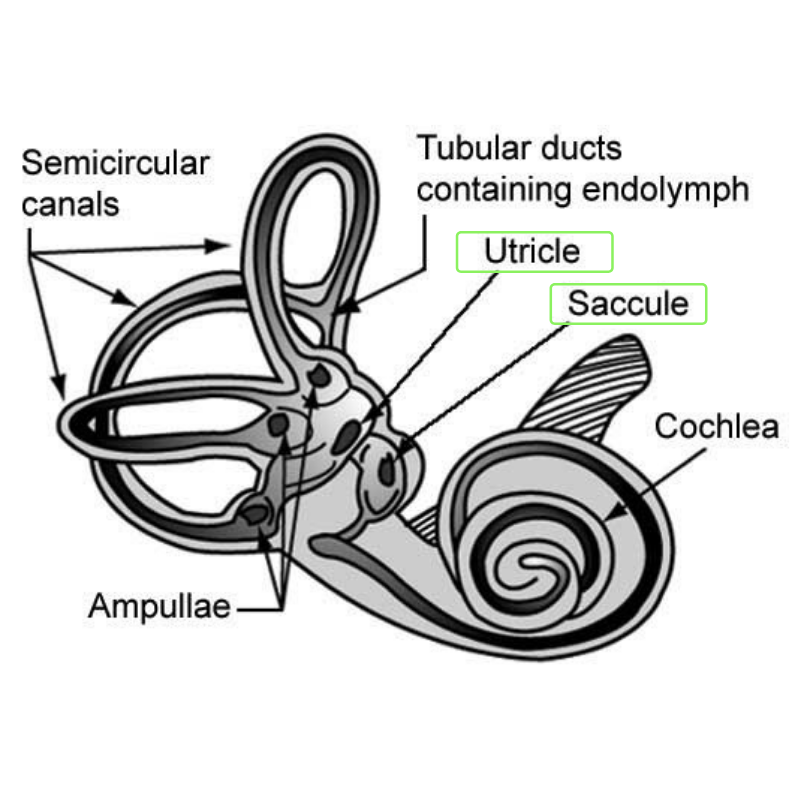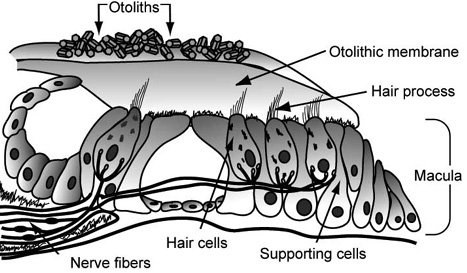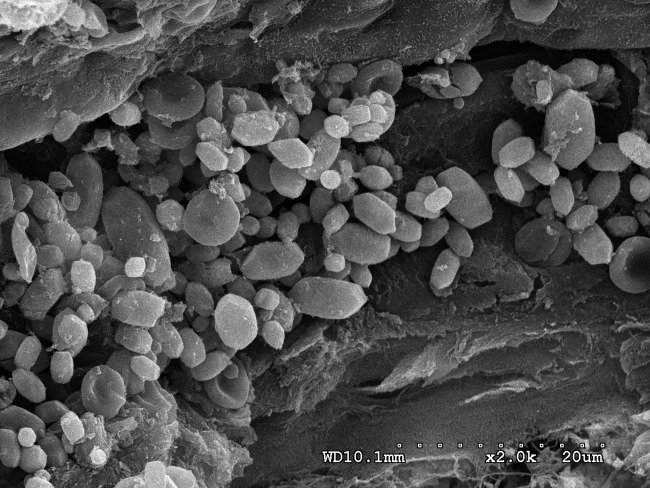What are the otoliths?
Hair cells in the utricle, from wellcomecollection.org
What are the otoliths?
Our inner ear has two parts: 1) the hearing component, the cochlea, and 2) the balance component, the vestibular organs.
There are two parts to our vestibular organs 1) the semicircular canals and 2) the otoliths. The otoliths are again made up of two parts 1) the utricle and 2) the saccule.
Where our semicircular canals sense rotational head movements, the otoliths sense vertical and horizontal linear movements, head tilt, and gravity. Emerging research also suggests that the otoliths have a role in spatial orientation and memory.
Anatomy of the otolith organs
The utricle is oriented horizontally, so it senses horizontal motion. The saccule is oriented vertically, so it senses vertical motion.
Both the utricle and saccule contain hair cells, a gelatinous layer, and a fibrous membrane. This membrane has otoconia embedded in it.
The otoconia are calcium carbonate crystals. These crystals are what give the otolith its name, as otolith is Greek for “ear stones”. The otoconia cause the membrane to be heavier than the structures and fluid around it.
When you move your head, gravity and the weight of the otoconia cause the membrane to move, which bends the hair cells, which sends signals about motion and head position to the brain via the vestibular nerve.
Scanning electron micrograph image of otoconia, from Kao, Parnes, & Chole 2016
Single human otoconium, from Walther et al. 2014
Otolith dysfunction
If the otoconia come loose and travel into the semicircular canals it results in Benign Paroxysmal Positional Vertigo (BPPV). This condition causes spells of vertigo triggered by changes in head position relative to gravity. This is the most common cause of vertigo and it is very effectively treated with vestibular rehab.
Head trauma can cause damage to the otoliths. This can result in BPPV, or can cause the otoliths to not function properly. Dysfunction of the otoliths can also be caused by other inner ear conditions but in some cases, the cause of otolithic dysfunction is unknown.
You can also become hypersensitive to otolithic stimulation. This could possibly be a result of a change in the signals the otolith sends to the brain, or a change in how the brain interprets and processes these signals.
Symptoms of otolith dysfunction
Non-rotatory vertigo (illusion of movement):
Feeling of rocking or swaying
Feeling like you are on a boat
Feeling like you are walking on a sponge
Feeling as if the ground falls away underneath you
Feeling as if the floor is shifting
Feeling like you are being pushed or pulled sideways, forwards, or backwards (pulsion)
Balance problems
Imbalance with quick changes in walking speed
Imbalance with sit to stand
Sensitivity to acceleration-deceleration (like riding in a car in stop and go traffic)
Sensitivity to up and down motions (like riding in an elevator)
Drop attacks (sudden falls without loss of consciousness, without neurological symptoms, and not due to a mechanical cause like tripping or slipping)
Evaluating the otoliths
To determine if otolithic dysfunction is causing your symptoms, assessment starts with a clinical interview to fully understand the symptoms you experience. A complete physical evaluation of inner ear and neurological balance functions is important to rule out any other causes for your symptoms.
Problems in the otoliths can cause a change in how you perceive vertical alignment. This can cause you to feel tipped to one side, even if you are sitting or standing straight. We can evaluate whether you have an altered sense of ‘subjective visual vertical’ using a test where we have you move a line to what you feel is straight up and down, without any other visual reference points.
We can also evaluate utricular function using the head heave test. This assesses the translational vesitbulo-ocular reflex (VOR) - the ability for your eyes to stay on target with fast lateral head movements. To perform this test, we ask you to keep looking at a target while your head is moved sideways.
VEMP testing is a type of vestibular function test that is performed by an audiologist. VEMP testing evaluates the function of the saccule (cVEMP test) and utricle (oVEMP test). This type of test involves electrodes placed on your neck and face to record electrical activity in your neck and eye muscles. During the test you listen to clicking sounds and are asked to lift your head or move your eyes. The electrodes measure the response of your muscles and determine how the otoliths react to sound stimulation.
Vestibular rehab for otolithic dysfunction
Vestibular rehab treatment to address otolithic dysfunction is tailored to your individual symptoms and challenges, and can depend on whether your difficulties are due to otolithic loss or hypersensitivity. Physiotherapy often includes balance training exercises, habituation exercises to build tolerance to movements that provoke symptoms, and a walking program. It may also involve otolithic stimulation exercises like walking and changing speeds, or up and down movements like gentle bouncing, squats, or sit to stand.
If you have displaced otoconia causing BPPV, we treat this with physical maneuvers that move the “loose crystals” out of the semicircular canals and back into the utricle.
Wondering if your symptoms could be due to problems with your otoliths? Want to know if vestibular rehab could help you? Get in touch to speak to one of our physiotherapists!
Thumbnail image source: wellcomecollection.org





